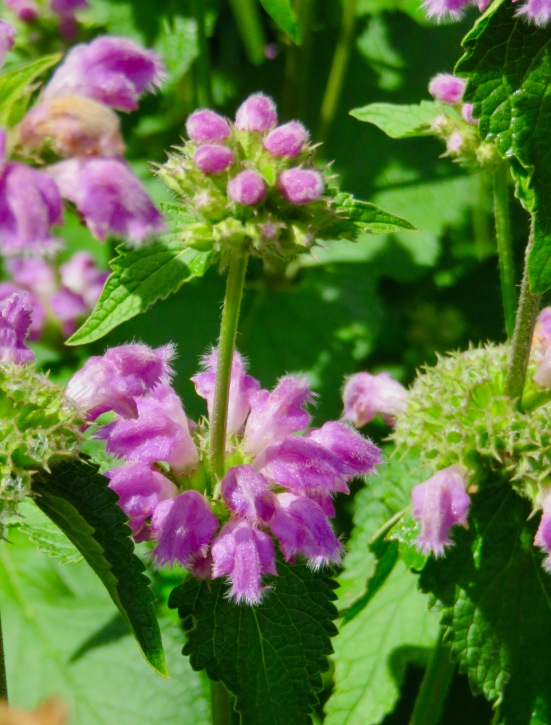One way to be pollinator-friendly in our neighborhood is to select plants for our own yard that supply pollinators with nectar and pollen. So many native pollinators are at work on a sunny early summer day in the Northern Plains. Bees of all sizes are busy yet stay mostly in the background.
This is true for this Mint family plant that may be a form of Monarda. Even in the hot afternoon sun, on approach, the herbaceous plant hums with a few bumble bees, but mostly the sound comes from various kinds of tiny bees no larger than a fly.

Flowers have stamens and anthers lay well protected inside the petals of this plant. Obtaining the nectar from each flower requires energy and commitment from the pollinator!

Native plants are most likely to have nectar available for the pollinators. After all, they are partners with pollinators that move pollen from flower to flower for seed formation. Unfortunately, some hybrid plants are bred for other features such as flower size and color without regard for nectar. Unaware, we may select plants that lack nectar.
In our region, these are some of the nectar-producing plants that bloom in early summer. Native dogwoods are still in bloom. Common milkweed will bloom soon, along with Joe Pye weed, false indigo, partridge pea and black-eyed Susans. Of course, some of these continue blooming into late summer.
A pollinator-friendly consideration is to select some plants for the yard with nectar that bloom at early season, some that bloom in mid-season and some that bloom late season. Beginning of summer is a fine time to add perennials. One may find nectar-producing plants for the parts of the season at the website www.wildones.org. Look for ones on the list you have seen locally to be sure the plants are a match for zone hardiness.
Thanks for visiting Plant Exchange Blog. We appreciate “Likes” your send our way when you enjoy topics and the loyal “Followers” who show up for weekly posts.
Happy beginning of summer!
Native plants are only better for providing nectar than exotics if the exotics have been bred to be less efficient at doing so. Some garden varieties of natives (here in the Santa Clara Valley and Santa Cruz Mountains) have been bred as extensively as some of the exotics, just because they are chaparral plants that, in their natural state, are less appealing for home gardens. Some of the exotics, such as monardia, catmint and rosemary, are much more appealing to pollinators. Some are fancier cultivars, but some might be similar to how they are found in the wild, wherever they are native to.